
Designing for the Future of Work
Caribou is an application designed to support people who work while traveling by helping them find workspaces and travel activities on the go.
Project
MHCI+D Graduate Project
My Role
Lead UX Designer
Team
1 UX Designer and 1 UX Researcher
My Responsibilities
Project Management, Research, Ideation, Sketching, Wireframes, UI Design, Digital Prototyping, Information Architecture, Visual System
Time Frame
5 Months
Toolkit
Figma, Adobe CC
Background
Supporting People Who Work While Traveling
As a part of a graduate project, I worked within a team of three to investigate how recent events have shaped the way we live, work, and play. We were interested in the future of work and exploring ways of supporting an evolving workforce. With remote work becoming more common, more and more people are pursuing the location-independent lifestyle that was once associated with digital nomads.
Caribou is an application designed to help traveling professionals make the most of their experience in their travel destination while also supporting their work productivity.
With just a touch, they can search for an optimal place to work on the go or explore nearby attractions and activities unique to their destination.
No more missed meetings or wasted lunch hours.
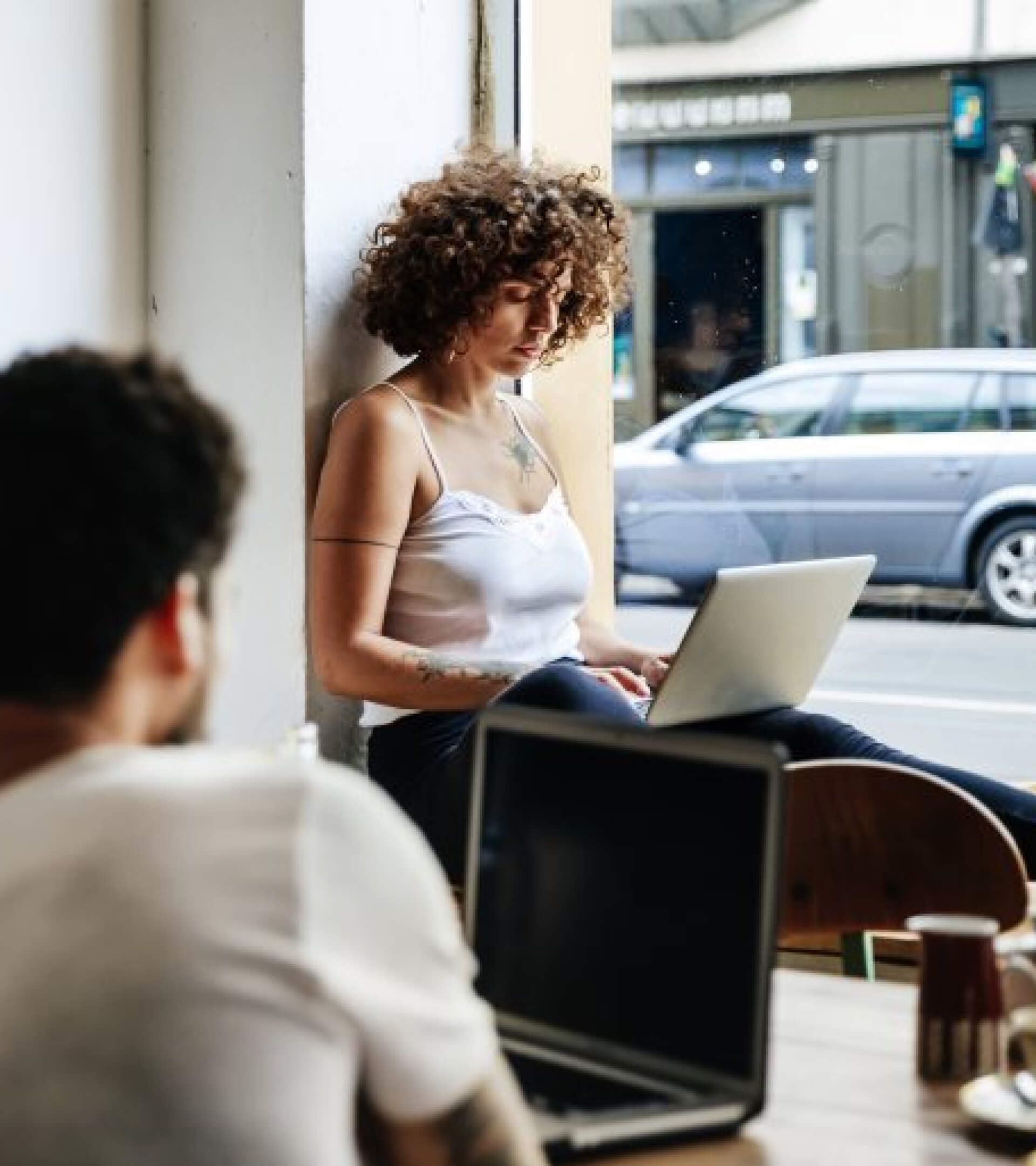
Background
Location Independence is the Future
In 2020, the entire world witnessed a seismic shift towards remote work, accelerated in large part due to the COVID-19 pandemic. This shift propelled many salaried professionals out of their tiny city homes to explore alternate ways of living, working and traveling.
We’ve seen the emergence of a new type of worker, “COVID nomads”, who are taking advantage of this new freedom to pursue location independence through a nomadic lifestyle.
96% increase in traditional workers working as digital nomads
from 3.2 million to 6.3 million in 2020
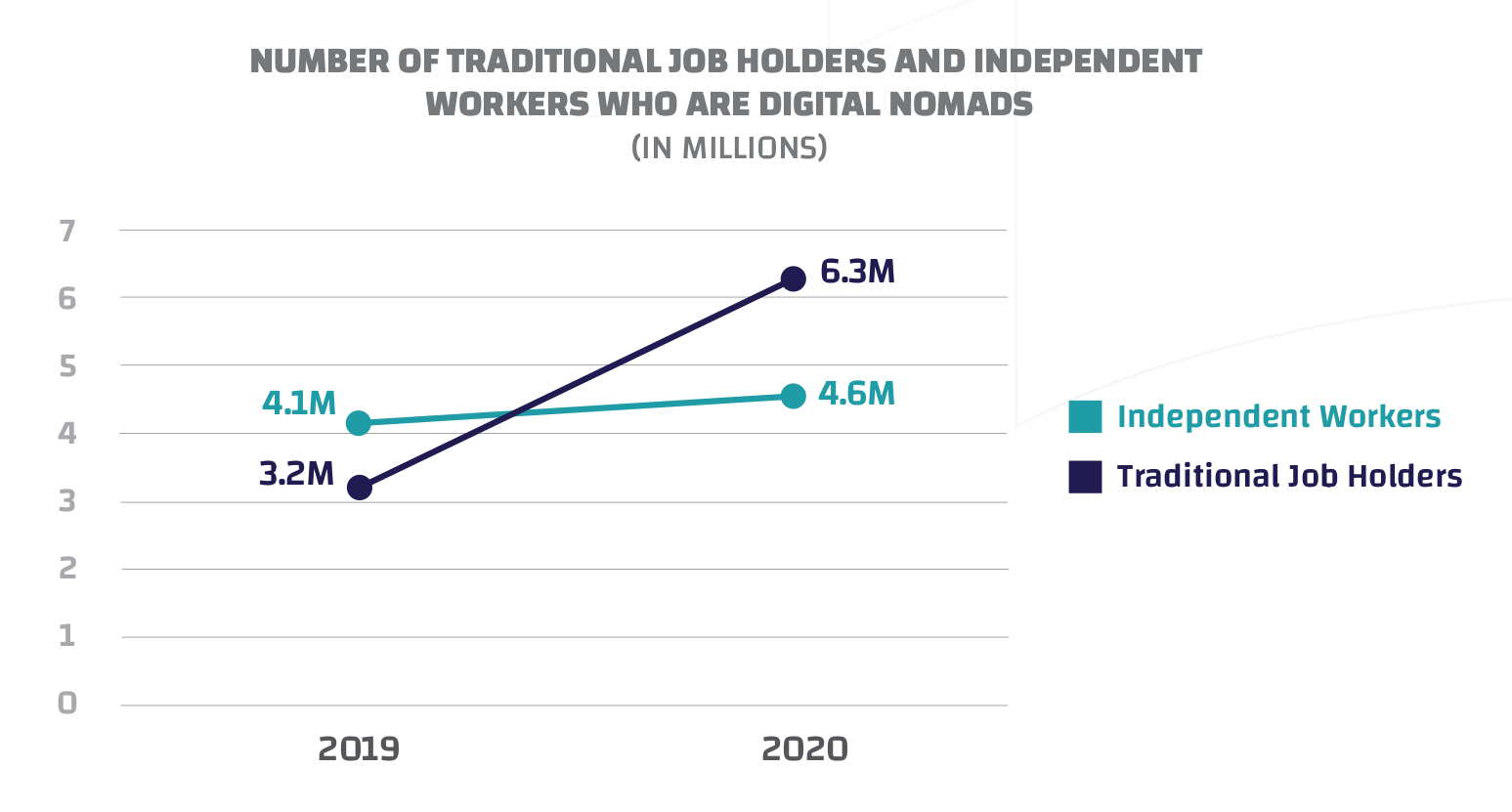
Before 2020, only 6% of the employed workforce primarily worked from home and about three-quarters of them had never even answered a work call from home. since then, there has been a sudden change in this statistic with a 49% increase in Americans describing themselves as digital nomads.
We started wondering what is pushing salaried professionals to pursue this lifestyle? When we started looking at the social, economic, technological, environmental and political factors to understand the trends over time that might have caused salaried professionals to rethink their location based lifestyle.
Research
Understanding the COVID Nomad Experience
With a well-defined primary stakeholder in mind we dove head first into research.
We wanted to accomplish three things:
- further distinguish the experience of remote workers, digital nomads, COVID nomads
- understand the ecosystems surrounding them
- and identify products and services currently catering our stakeholders
Our secondary research helped us learn more about common pain points, motivations and experiences of COVID nomads which informed our interviews.
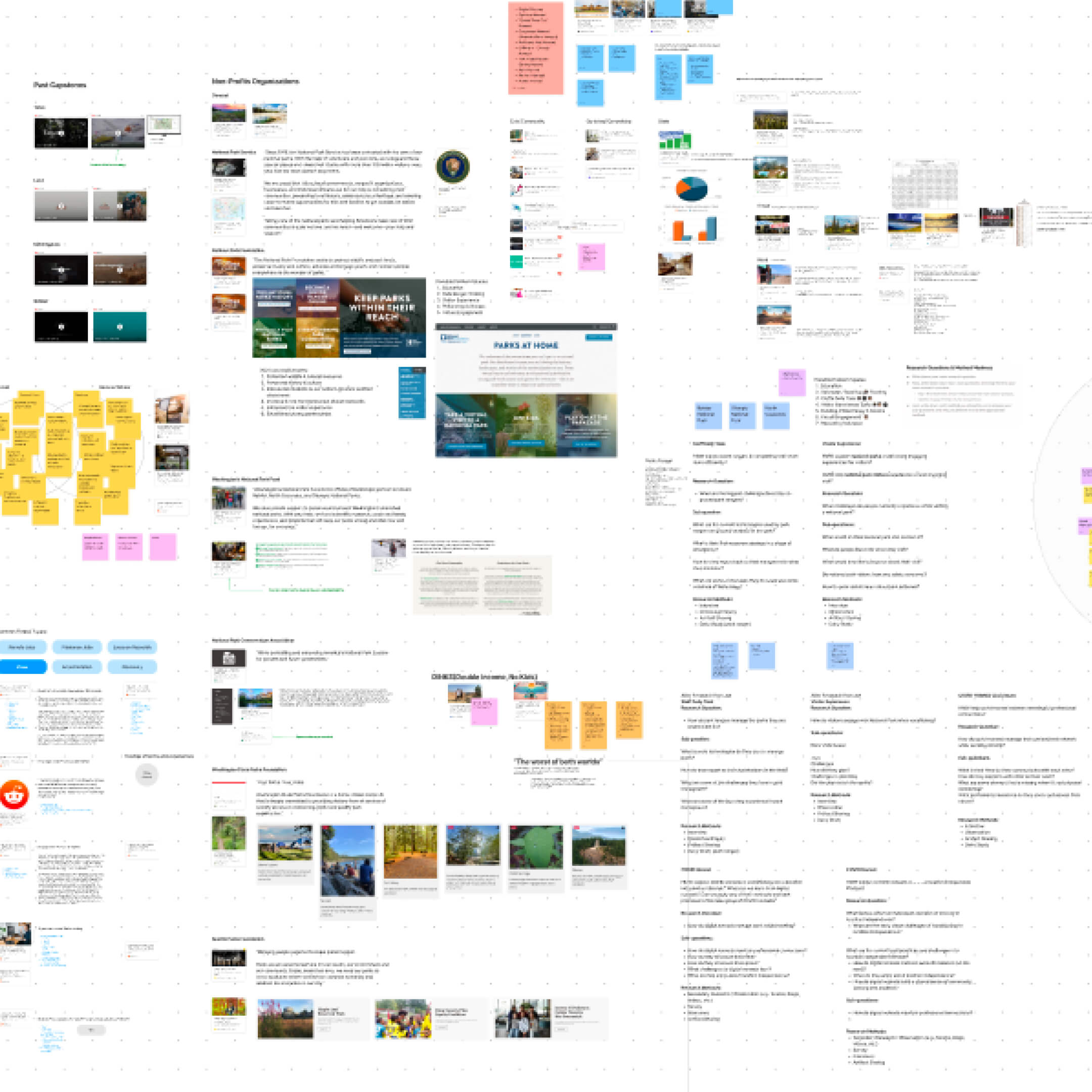
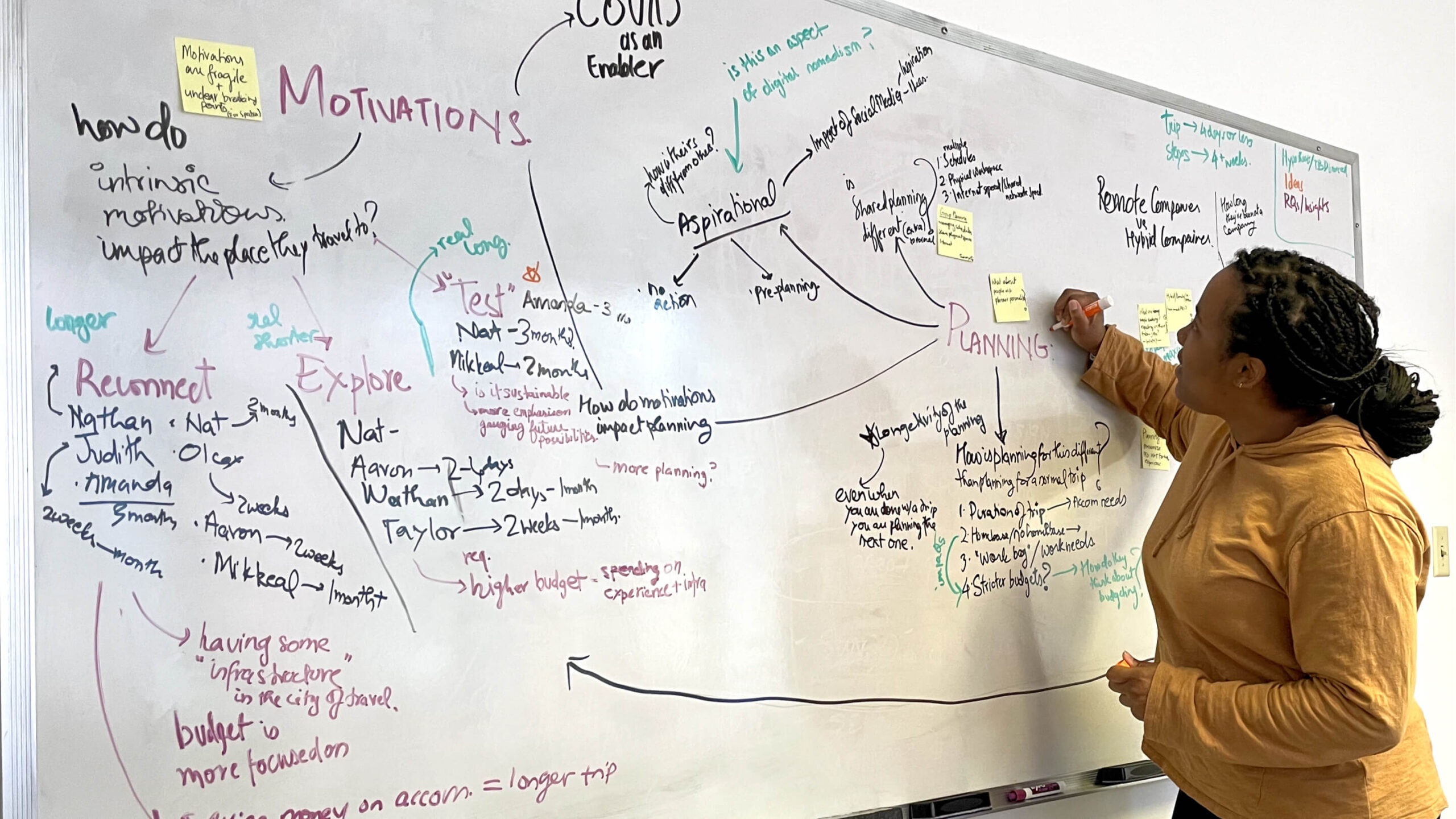
Snowball Recruitment
Recruitment through word-of-mouth and posting on professional and community social channels.
8 Participants
People who have worked while traveling within the past two years as full-time salaried professionals or long term contract based employees.
Semi-Structured Interviews
Remote interviews with artifact sharing to better understand their journeys and narrow our area of focus.
We conducted remote interviews with artifact sharing to better understand their journeys and narrow our area of focus. Recruitment was done through word-of-mouth and posting on professional and community social channels screening for participants who have worked while traveling within the past two years as full-time salaried professionals or long term contract based employees.
We interviewed eight participants between the ages of 25 to 41. All became full-time remote employees during the pandemic, with the majority doing project-driven work within tech in full-time salaried or contract jobs. Most choose to travel both domestically and internationally while keeping a permanent home base in the United States.
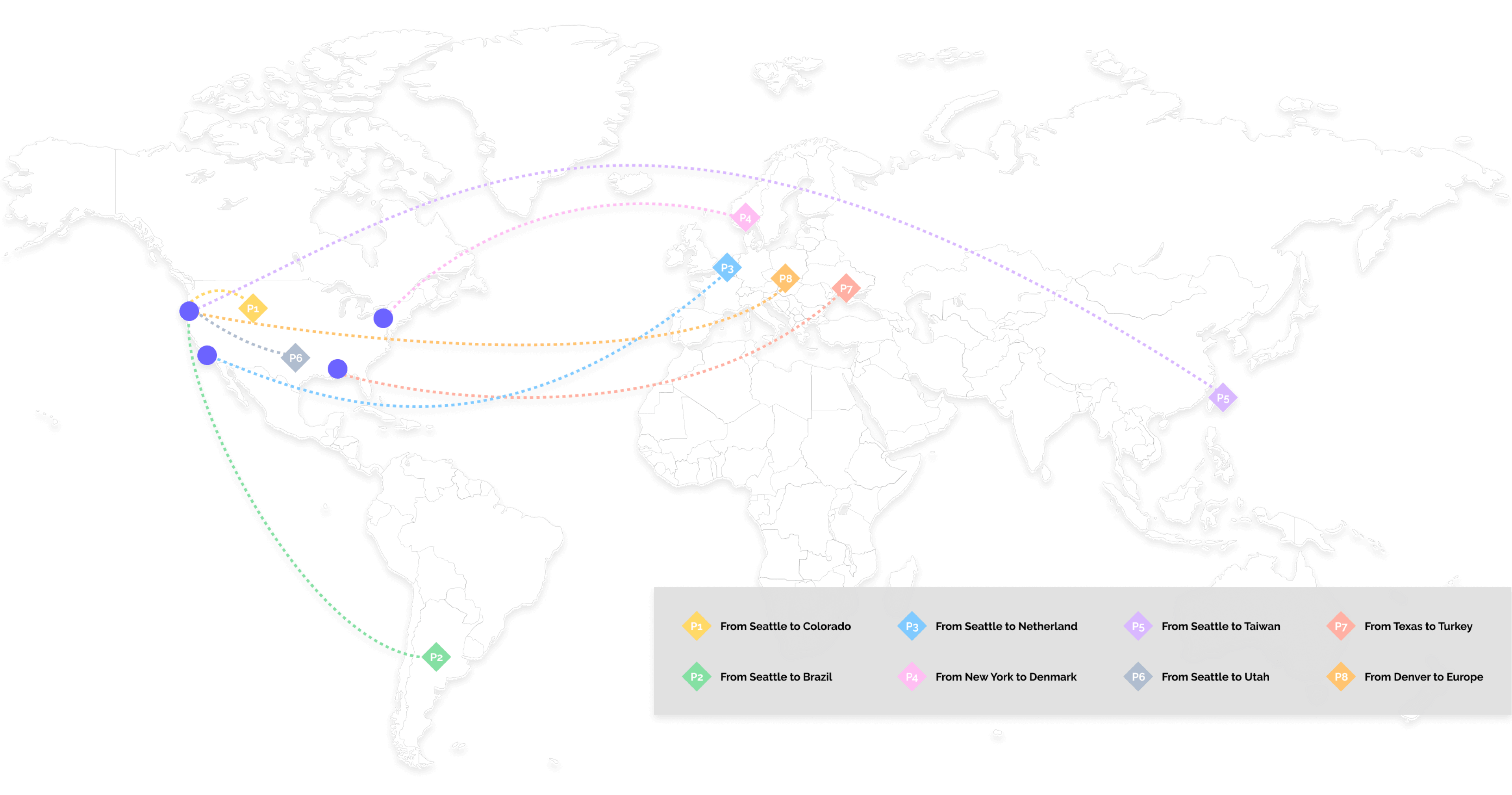
KEY FINDING
Importances of Maintaining a Work-Travel Balance
Through conversations with salaried professionals who have been traveling all over the world we found out people view establishing an office-like work environment as essential to maintaining work productivity while traveling. Salaried professionals are looking for the best of both worlds but struggle to manifest it, which presented a very interesting challenge in front of us.
How might we create an environment that supports salaried professionals with their working productivity while traveling?
Competitor Analysis
A Gap in the Market
We looked at what already existed on the market to learn from and spot opportunities. The travel and work productivity markets are extremely saturated with products and services like trip advisor and WeWork dominating. We did, however, notice an opportunity to bridge the gap between work and travel and help people make the most of the unique experiences they were having.

Ideation
Exploring Many Approaches
We came up with three design principle to act as a north star to guide our design process based on pain points and opportunities identified through our research.
Design for Flexibility
Support and accomodate varying work needs, while allowing for spontaneous trave
Design for Balance
Respect the dual nature of their experience by balancing work and travel needs.
Design for Delight
Reflect the spirit of adventure sought by travelers by incorporating moments of delight and exploration.
We started by brainstorming 60 concepts that could address this issue, ranging from wifi locators to shippable work kits.
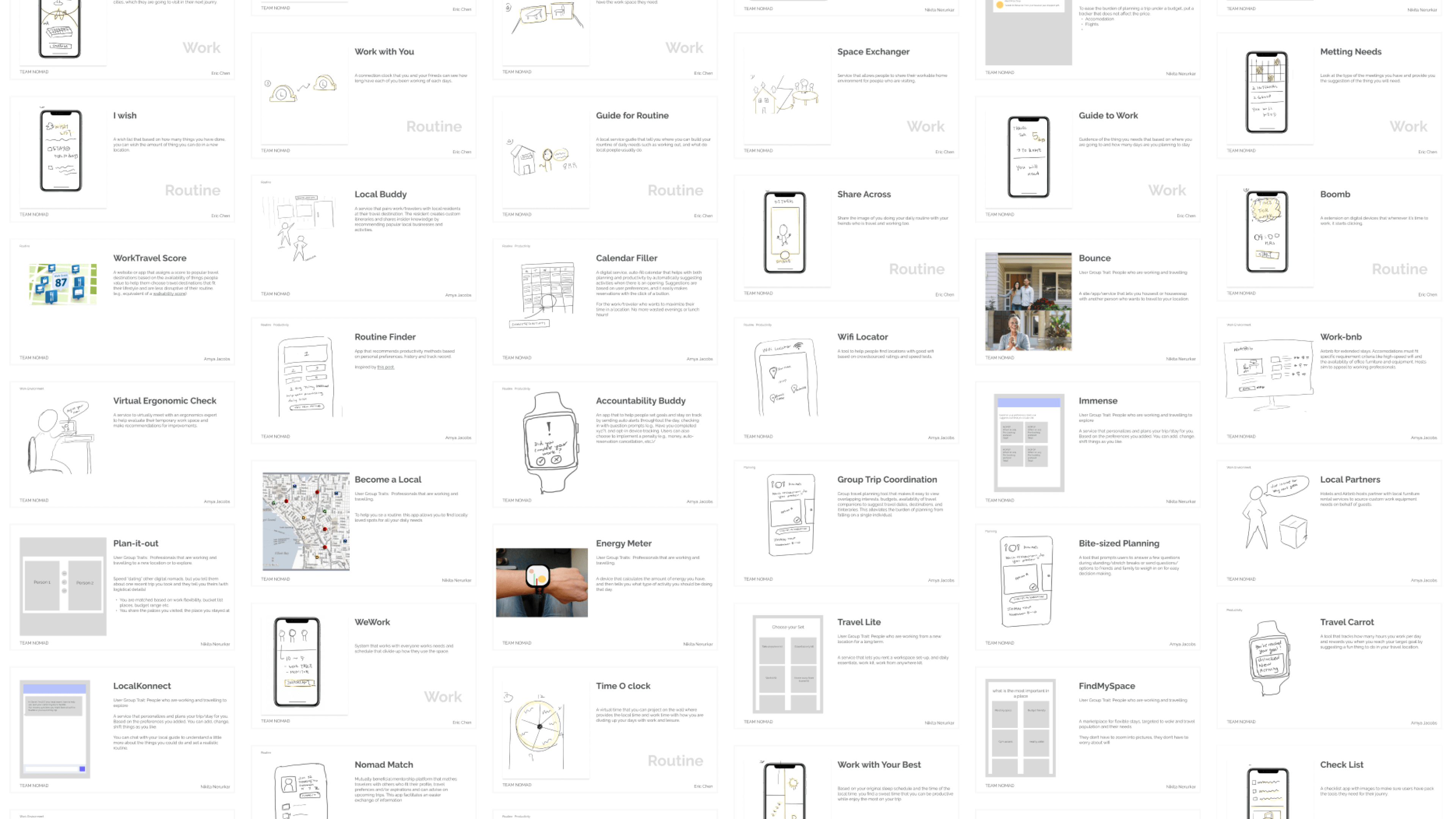
We narrowed down our focus based on interest, current competitors in the market, feasibility, and how closely they align with our design principles and landed on two possible directions.
Our two approaches are like two sides of a coin and focused on either helping people find optimal work environment that already exists or helping them create one on the go.
We had a hypothesis, but wanted to test our assumptions.
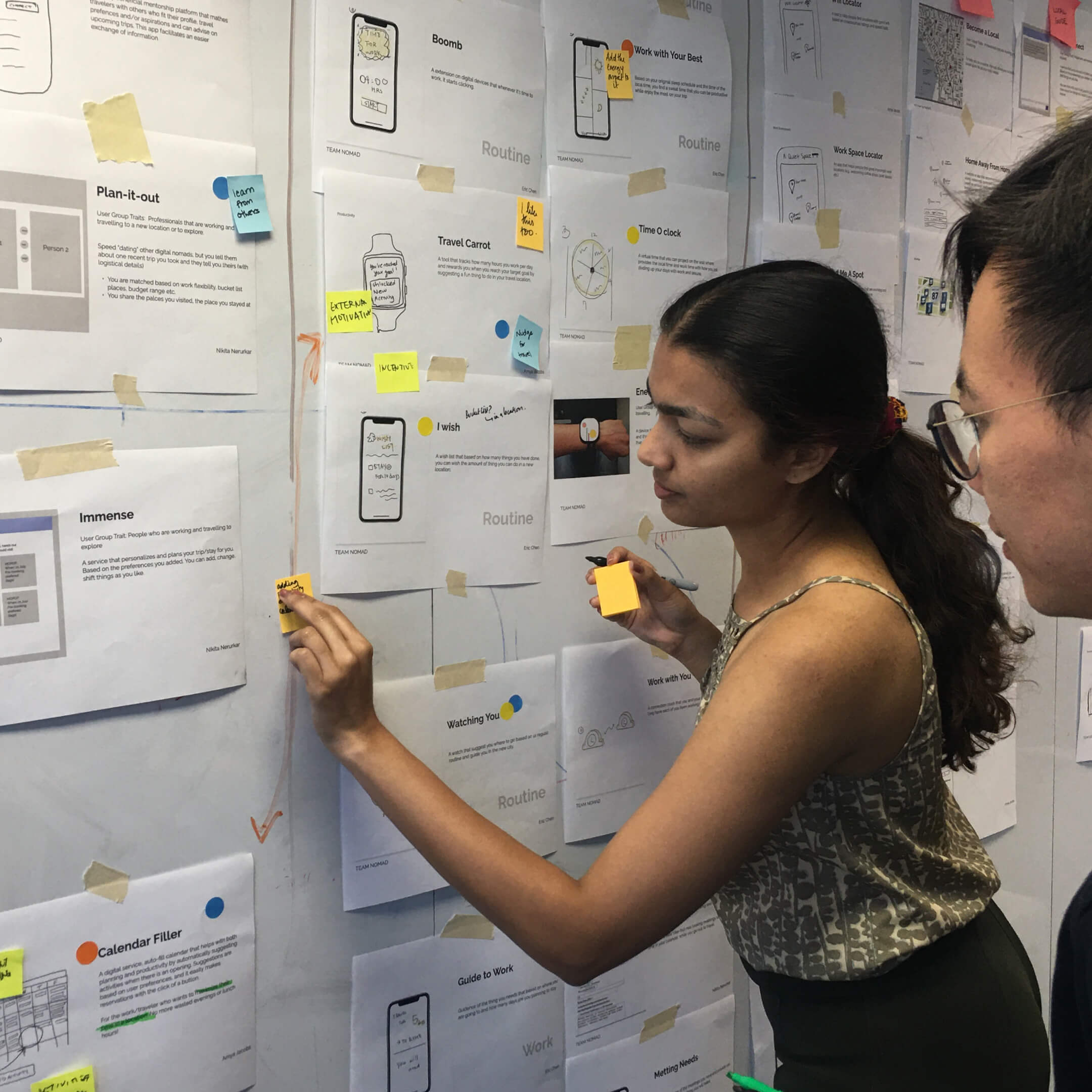
Concept Testing
Validating Our Concept
The people we are trying to serve have such unique approaches to this lifestyle, so we conducted concept testing to ensure that we were coming up with a design direction that could meet their diverse needs. I led 3 of 8 testing sessions as we presented our concepts to people who have recently worked while traveling and fulfilled the same criteria of our earlier foundational research.
Our first approach was the clear winner.
While they didn’t like all of the features we proposed, our users confirmed that they liked the core function of the concept and could see use for it. We also walked away with additional insights to apply to our future design.
01
Make the search process easy
People are already trying to use the tools out there, but none of them make the location search process easy. Participants mentioned crucial details being left out of the search process-- like the availability of outlets in a location, or how welcoming the environment is to remote workers.
02
While working, people want focus
Some of the features we considered included alerts and notifications with interesting facts about the location, but that wasn’t appealing to our participants. They have a hard enough time getting into the flow when they are working while traveling, they don’t need anything extra to break their focus.
03
Consider the time in between work
Our early concepts prioritized work productivity, but that didn’t encompass people’s full experience working while travelling. Our research participants were excited by the idea of a tool that could help them with both work and free time in their travel destination.
Storyboard
Defining Our Primary Use Case
Next, we refined our concept by defining a primary use case. We intentionally designed for people who may have:
- unplanned, unexpected needs
- autonomy over their work
- be traveling in a city
These are the kinds of people we encountered in our primary research so our design reflects that.
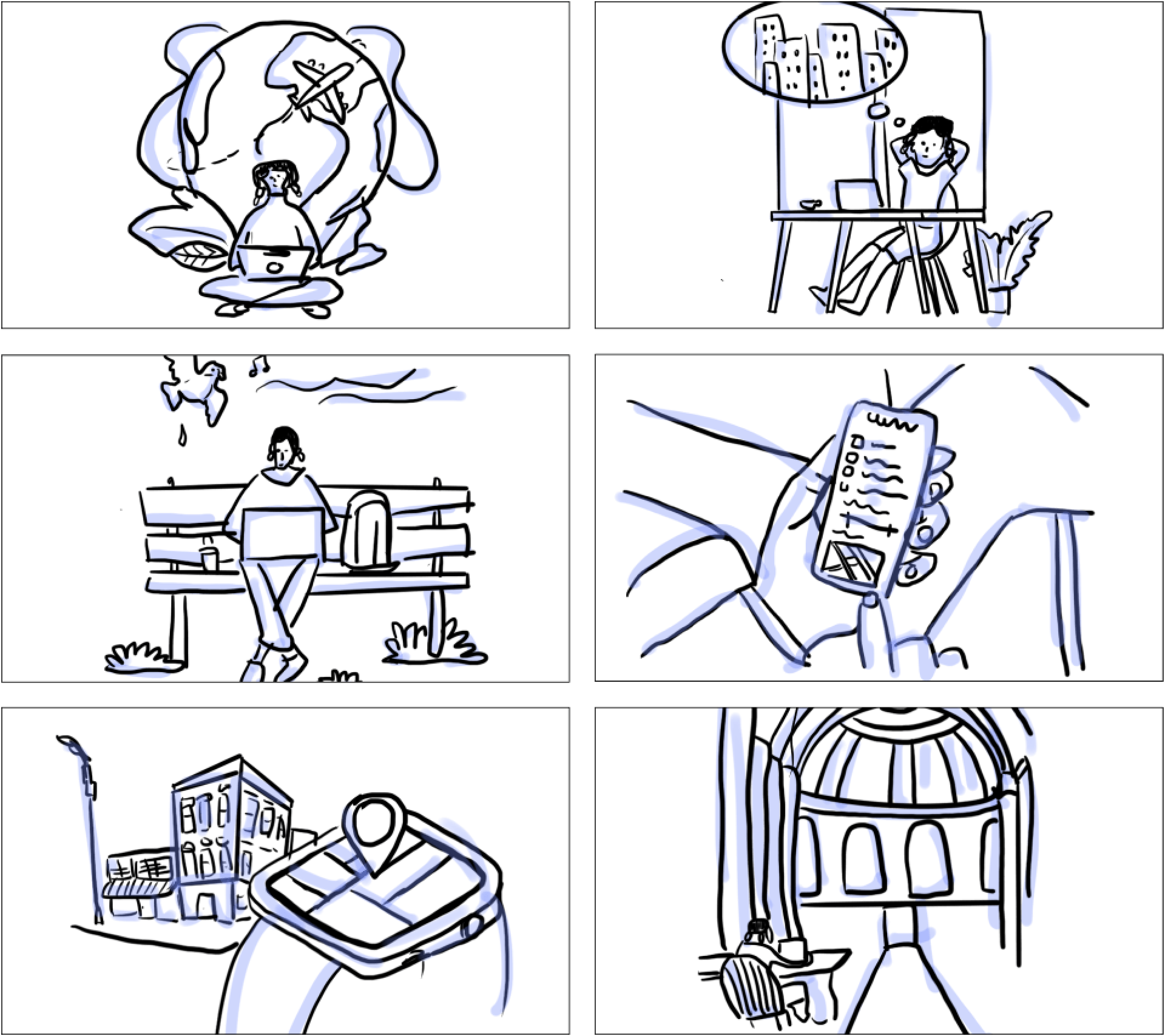
Design
An App That Bridges the Gap
We worked as a team to talk through possible features and layouts utilizing sketches to quickly ideate, communicate, and align on what we wanted.


Next, I translated that into lo-fi digital wireframes to be able to communicate our concept to external stakeholders—like our instructors and advisors.
I designed a mobile app that bridges the gap between work productivity and travel exploration.
With a simple switch, traveling professionals can search for an optimal place to work on the go or search for places to enjoy time off in their travel destination.
The app is intended for people who may not have access to a suitable workspace, and want to explore the place that they are visiting during their work day.

IA & Data
Thinking Through the Structure
Based on the feedback we received, we put in a conscious effort to think through every interaction and bring consistency as we build our information architecture and user flow. The structure is intentionally simple with both the work and explore sides mirroring each other.
I led these efforts and created this diagram to illustrate the app structure.

I thought through the way data would be categorized in order for people to easily use our search function, and also tried to make these mirror each other through similar levels of complexity and granularity. To illustrate this, I researched possible API integrations and created an entity-relationship diagram.
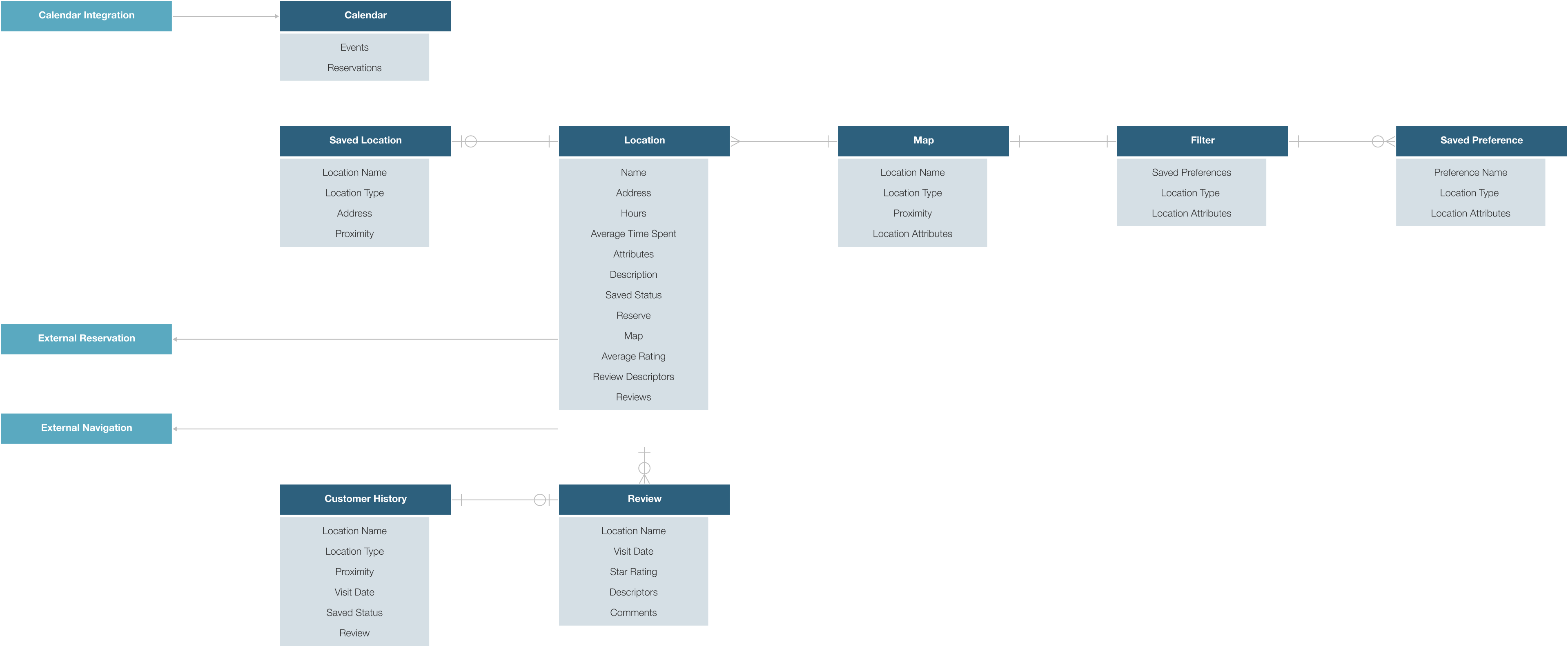
Visual System
Highlighting Dual Functionality
To put the finishing touch on our concept, we decided on a name and defined the visual system. We decided on Caribou, one of the most migrant animals to set a playful tone. Our color palette is made up of complementary colors to emphasize the contrast between the two modes. We used a mix of photography and iconography in our components to establish consistency of experience across the app.
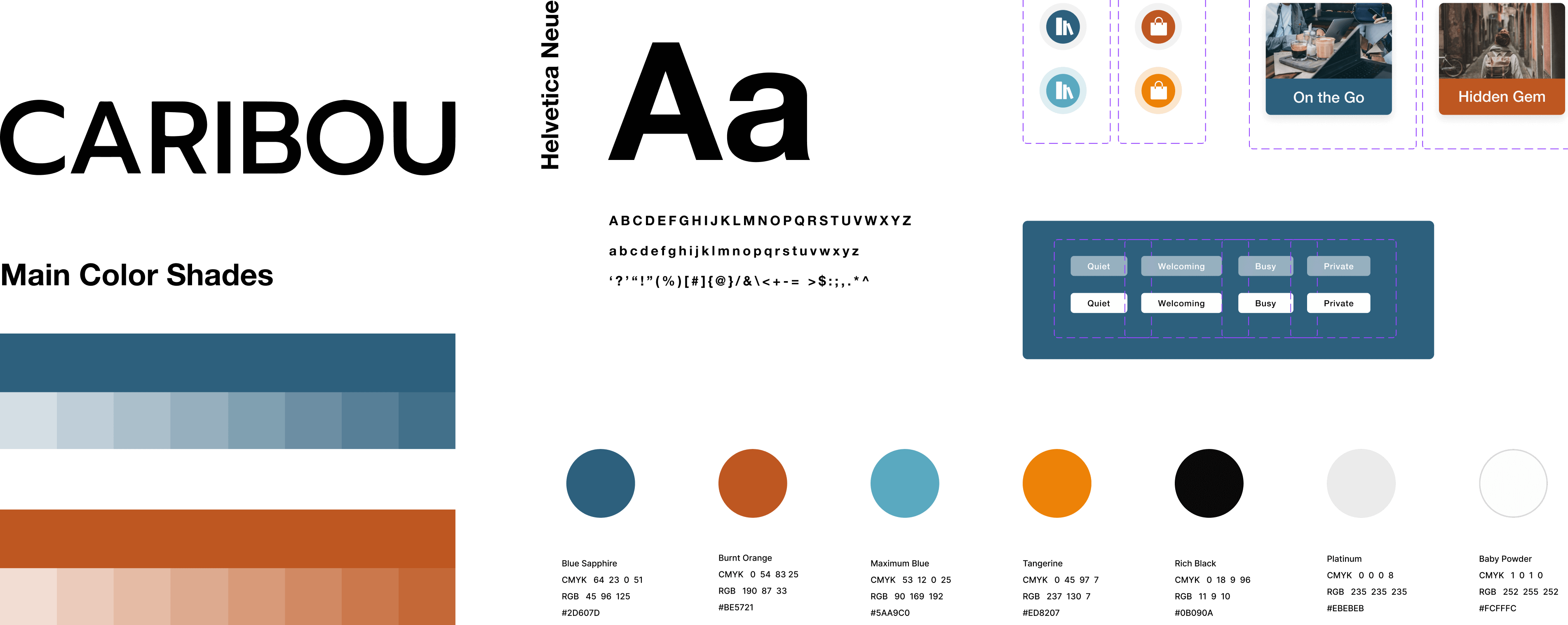
Solution
Meet Caribou
Work while traveling shouldn’t feel like work from home. By switching between “work” and “explore” mode, Caribou helps users maximize their experience by achieving their ideal work-travel balance.


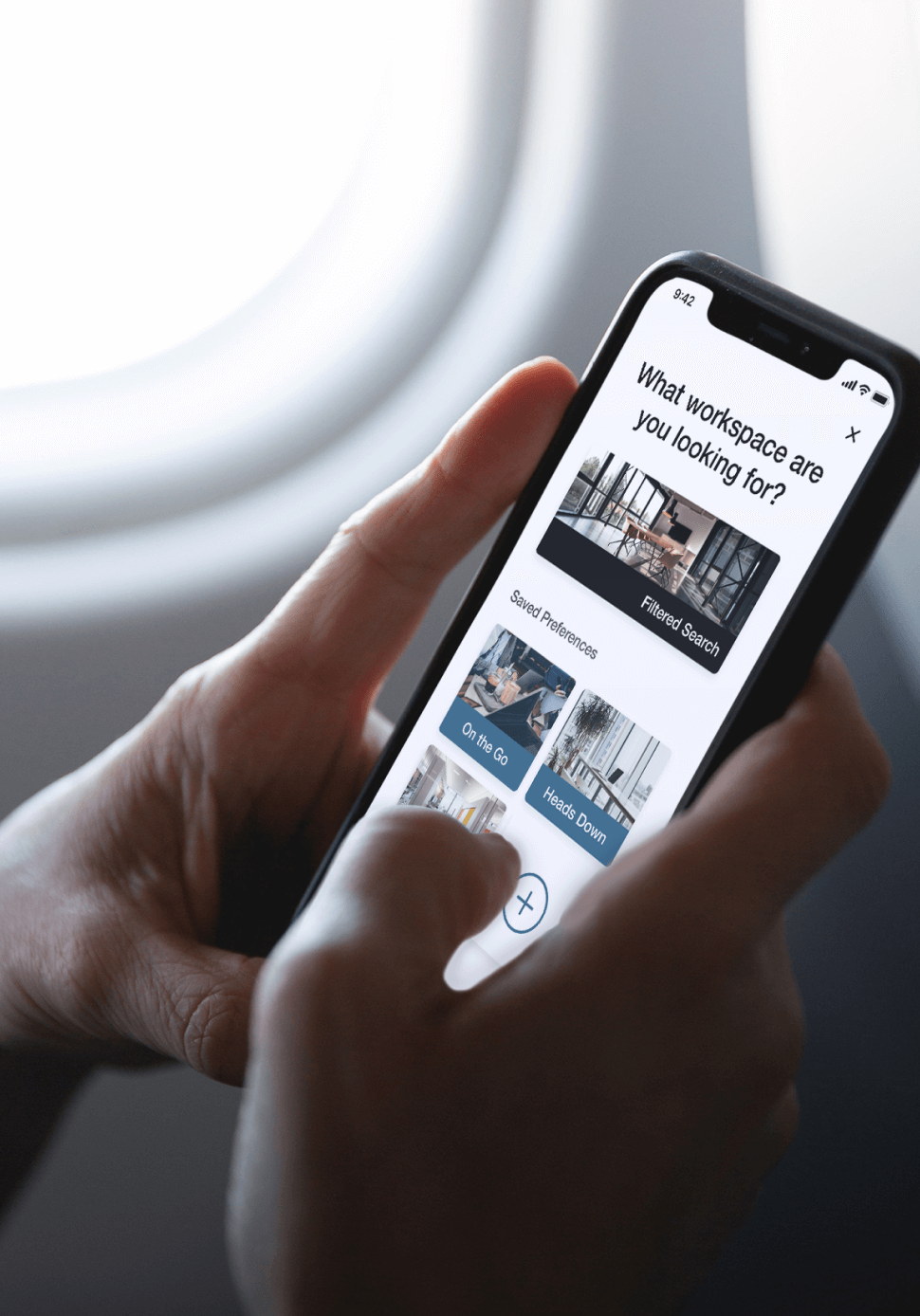
Core features of the design include:
- Dual functionality with the two modes -- work and explore
- Multi-level search & filtering, like
- Quick match
- Easy filtering, and
- Saveable workspace and activity preferences
- Quick match
- Location tags and categorization that matches what people what to know
- We also tried to streamline interactions to make it easy to use

Reflection
Next Steps
For our inital product we prioritized thinking through our key features, but if we had more time we would continue to develop our concept.
01
Usability Testing
Match our concept design to the mental model of our users. Test our features and their validity.
02
Map Third Party Integrations
Mapping data intergration and handovers with collaborating services and platforms.
03
Go-to-Market Strategy
Build a more strategically sound buisness and monetization plan.
